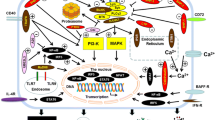Abstract
Interleukin-7 (IL-7) is an essential cytokine for the development and homeostatic maintenance of T and B lymphocytes. Binding of IL-7 to its cognate receptor, the IL-7 receptor (IL-7R), activates multiple pathways that regulate lymphocyte survival, glucose uptake, proliferation and differentiation. There has been much interest in understanding how IL-7 receptor signaling is modulated at multiple interconnected network levels. This review examines how the strength of the signal through the IL-7 receptor is modulated in T and B cells, including the use of shared receptor components, signaling crosstalk, shared interaction domains, feedback loops, integrated gene regulation, multimerization and ligand competition. We discuss how these network control mechanisms could integrate to govern the properties of IL-7R signaling in lymphocytes in health and disease. Analysis of IL-7 receptor signaling at a network level in a systematic manner will allow for a comprehensive approach to understanding the impact of multiple signaling pathways on lymphocyte biology.
Similar content being viewed by others
Author information
Authors and Affiliations
Corresponding authors
Supplementary information
Rights and permissions
About this article
Cite this article
Palmer, M., Mahajan, V., Trajman, L. et al. Interleukin-7 Receptor Signaling Network: An Integrated Systems Perspective. Cell Mol Immunol 5, 79–89 (2008). https://doi.org/10.1038/cmi.2008.10
Received:
Accepted:
Issue Date:
DOI: https://doi.org/10.1038/cmi.2008.10
- Springer Nature Limited
Keywords
This article is cited by
-
Transcriptomic characterization of tissues from patients and subsequent pathway analyses reveal biological pathways that are implicated in spastic ataxia
Cell & Bioscience (2022)
-
Immune Memory in Aging: a Wide Perspective Covering Microbiota, Brain, Metabolism, and Epigenetics
Clinical Reviews in Allergy & Immunology (2021)
-
The effect of co-occurring lesions on leukaemogenesis and drug response in T-ALL and ETP-ALL
British Journal of Cancer (2020)
-
Interleukin-7 protects against bacterial respiratory infection by promoting IL-17A-producing innate T-cell response
Mucosal Immunology (2020)
-
Persistent coxsackievirus B4 infection induces microRNA dysregulation in human pancreatic cells
Cellular and Molecular Life Sciences (2017)




